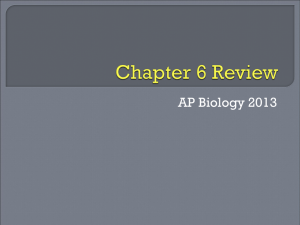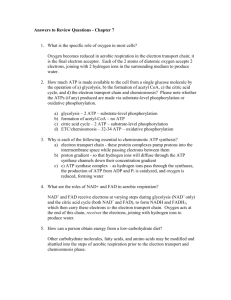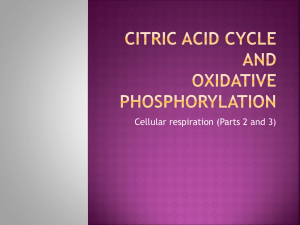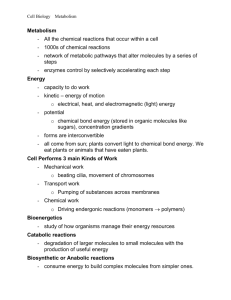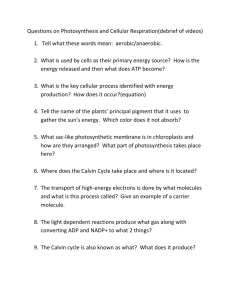Cellular Respiration Test. Answer each question with a True or
advertisement
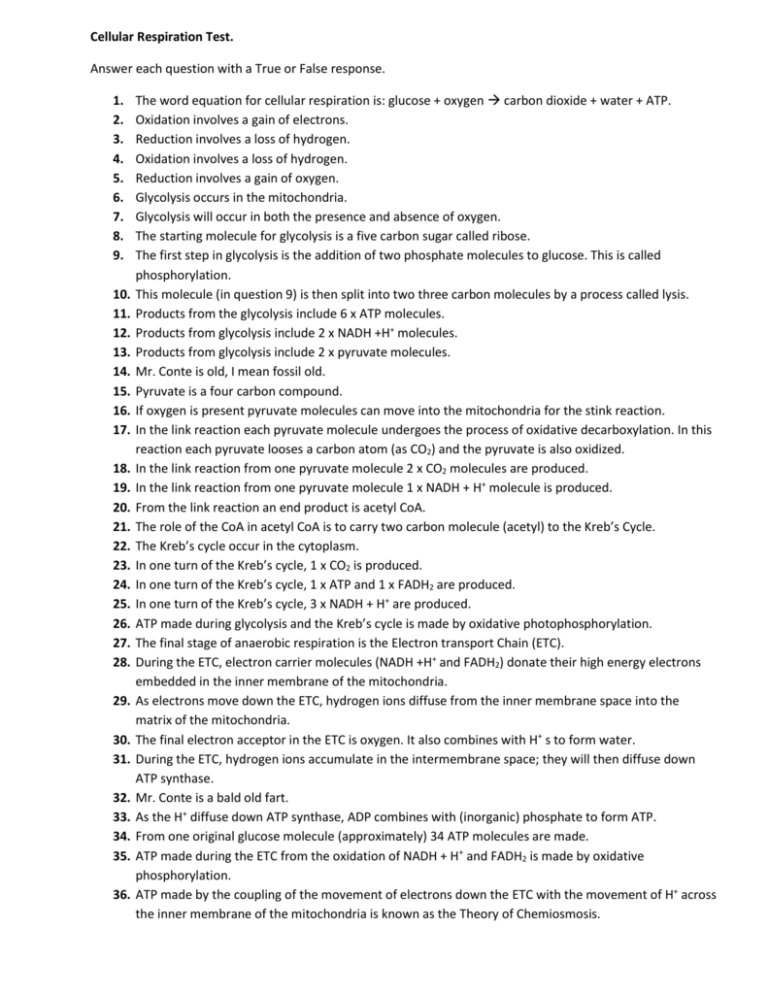
Cellular Respiration Test. Answer each question with a True or False response. 1. 2. 3. 4. 5. 6. 7. 8. 9. 10. 11. 12. 13. 14. 15. 16. 17. 18. 19. 20. 21. 22. 23. 24. 25. 26. 27. 28. 29. 30. 31. 32. 33. 34. 35. 36. The word equation for cellular respiration is: glucose + oxygen carbon dioxide + water + ATP. Oxidation involves a gain of electrons. Reduction involves a loss of hydrogen. Oxidation involves a loss of hydrogen. Reduction involves a gain of oxygen. Glycolysis occurs in the mitochondria. Glycolysis will occur in both the presence and absence of oxygen. The starting molecule for glycolysis is a five carbon sugar called ribose. The first step in glycolysis is the addition of two phosphate molecules to glucose. This is called phosphorylation. This molecule (in question 9) is then split into two three carbon molecules by a process called lysis. Products from the glycolysis include 6 x ATP molecules. Products from glycolysis include 2 x NADH +H+ molecules. Products from glycolysis include 2 x pyruvate molecules. Mr. Conte is old, I mean fossil old. Pyruvate is a four carbon compound. If oxygen is present pyruvate molecules can move into the mitochondria for the stink reaction. In the link reaction each pyruvate molecule undergoes the process of oxidative decarboxylation. In this reaction each pyruvate looses a carbon atom (as CO2) and the pyruvate is also oxidized. In the link reaction from one pyruvate molecule 2 x CO2 molecules are produced. In the link reaction from one pyruvate molecule 1 x NADH + H+ molecule is produced. From the link reaction an end product is acetyl CoA. The role of the CoA in acetyl CoA is to carry two carbon molecule (acetyl) to the Kreb’s Cycle. The Kreb’s cycle occur in the cytoplasm. In one turn of the Kreb’s cycle, 1 x CO2 is produced. In one turn of the Kreb’s cycle, 1 x ATP and 1 x FADH2 are produced. In one turn of the Kreb’s cycle, 3 x NADH + H+ are produced. ATP made during glycolysis and the Kreb’s cycle is made by oxidative photophosphorylation. The final stage of anaerobic respiration is the Electron transport Chain (ETC). During the ETC, electron carrier molecules (NADH +H+ and FADH2) donate their high energy electrons embedded in the inner membrane of the mitochondria. As electrons move down the ETC, hydrogen ions diffuse from the inner membrane space into the matrix of the mitochondria. The final electron acceptor in the ETC is oxygen. It also combines with H+ s to form water. During the ETC, hydrogen ions accumulate in the intermembrane space; they will then diffuse down ATP synthase. Mr. Conte is a bald old fart. As the H+ diffuse down ATP synthase, ADP combines with (inorganic) phosphate to form ATP. From one original glucose molecule (approximately) 34 ATP molecules are made. ATP made during the ETC from the oxidation of NADH + H+ and FADH2 is made by oxidative phosphorylation. ATP made by the coupling of the movement of electrons down the ETC with the movement of H+ across the inner membrane of the mitochondria is known as the Theory of Chemiosmosis. Photosynthesis Test. Answer each question with a True or False response. 1. 2. 3. 4. 5. 6. 7. 8. 9. 10. 11. 12. 13. 14. 15. 16. 17. 18. 19. 20. 21. 22. 23. 24. 25. 26. 27. 28. 29. 30. 31. The word equation for photosynthesis is: carbon dioxide + water glucose + oxygen. Photosynthesis consists of the light dependent reaction and the light independent reaction. The light dependent reaction occurs in the stroma of mitochondria. The products of the light dependent reaction are oxygen, carbon dioxide and NADPH + H+. The products of the light dependent reaction are oxygen, NADPH + H+ and ATP. The products of the light dependent reaction are ATP, glucose and NAD+. Mr. Conte is bald. In the light dependent reaction glucose molecules are split into oxygen and hydrogen. In the light dependent reaction electrons from photosystem I (PS I) pass down an ETC and are picked up by NADP+. In the light dependent reaction electrons that are lost from PS I are replaced by electrons that have been transported from PS II. Kinetic energy photoactivates PS I and light energy photoactivates PS II. As electrons travel from PS II to PS I, hydrogen ions are pumped into the thylakoid space from the stoma. As the hydrogen ion concentration increases in the thylakoid space the hydrogen ions move down their concentration gradient through ATP synthase and ATP is formed. NADP+ gets oxidized to NADPH + H+ in the light dependent reaction. ATP formed when electrons move in one direction (and are not cycled) from PS II to PS I and to NADP+ is call non-cyclical photophosphorylation. ATP formed when electrons are cycled around from PS II back to the ETC of PS I is formed by cyclical photophosphorylation. ATP made in the light dependent reaction (regardless if it cyclical photophosphorylation or non-cyclical photophosphorylation) via the coupling of the movement of electron down the ETC with the movement of hydrogen ions across the thylakoid membrane is known as the Theory of Chemiosmosis. The Light Independent Reaction occurs in the matrix of chloroplasts. The NADPH + H+ and ATP made during the light dependent reaction are used in the light independent reaction. The three stages of the light independent reaction are: carbon fixation, reduction and regeneration of an oxygen acceptor. During the light independent reaction, ribulose bisphosphate (RuBP) joins with CO2 using the enzyme RuBP carboxylase. During the light independent reaction oxygen gas is produced. During the light independent reaction glycerate -3- phosphate (GP) is reduced to triose phosphate (TP). Some TP is used to regenerate RuBP. Some TP follows a biochemical pathway to synthesise sugars. Some TP follows a pathway to synthesise carbon dioxide. ATP is used in the light independent reaction and is converted to ADP. NADPH + H+ is used in the process to fix CO2 to RuBP. In the process for question 28 NADPH + H+ is oxidized to NADP+ and then is used in the light dependent reaction. Mr. Conte has a shiny head (with no brain inside). I enjoyed this test.


